After all the fanfare, what’s it really all about?
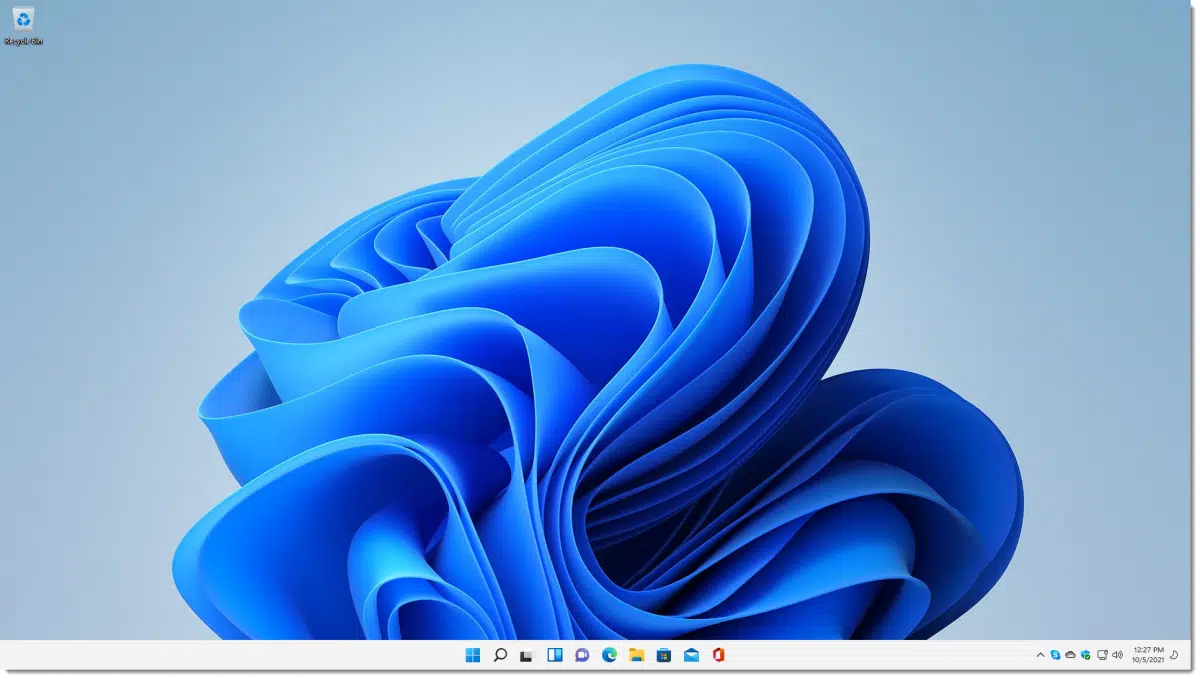
When it became available, I installed Windows 11 on one of my virtual machines so I could give it a try before committing to it.
I gotta say… I’m kinda underwhelmed.
But that may be OK.
There are a lot of Windows 11 reviews out already, and I’m not going to try to duplicate what they have to say. Instead, I’m going to focus on the changes you’ll notice right away, and the things that will impact the average (not power) user.

Windows 11
Windows 11 is prettier, with some cleaner, updated user-interface elements and major changes to the taskbar and Start menu. It also expands on a couple of Windows 10 features. At this point, however, unless you’re really eager to try it, there’s no compelling reason to upgrade to Windows 11.
It’s… pretty?
The first thing you’ll notice is that Microsoft has refreshed the look and feel of Windows once again. Icons and controls have all been updated to a new standard. Windows File Explorer is a good example.
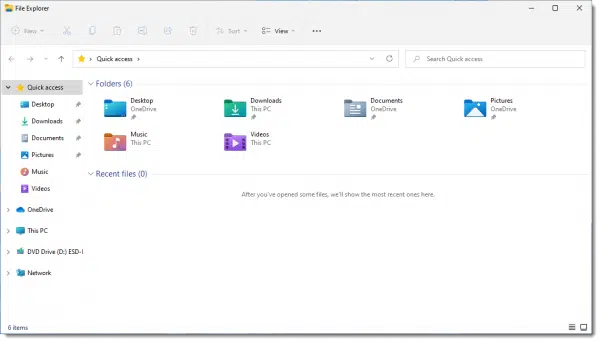
It’s pretty, and that’s what you’ll notice first, especially on the taskbar and Start menu (see below). I can’t say that it adds a lot of value, but neither does it detract from anything.
In the same category as “pretty”, I suppose, the sounds associated with Windows have been updated.
Help keep it going by becoming a Patron.
The taskbar & Start menu
The next thing you’ll notice is that your taskbar has changed.

It’s on the bottom. Only. You can no longer move it to the side or top of your display. This is both good and bad. On one hand, having it on the side allowed you to make better use of screen real estate on wide displays, as I do. On the other hand, people are often very confused when the taskbar seems to move itself to somewhere they don’t expect. Dealing with that is one of my most popular YouTube videos.
This change reduces complexity at the cost of flexibility.
The only real configuration change you can make to the taskbar’s location is to have it align to the left instead of its new, centered default.
The Start menu looks different as well, having discarded the “live tiles” introduced in Windows 8.
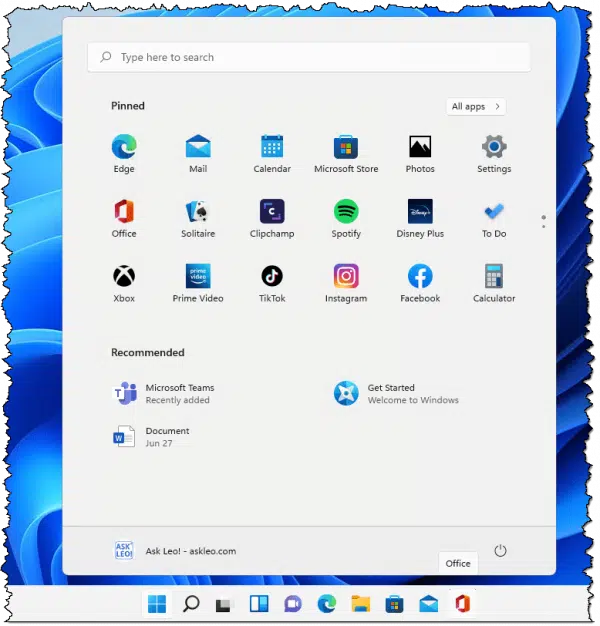
The option to resize tiles has been removed. The collection of pinned apps will scroll (note the two dots on the right, indicating that there are two pages of pins), and clicking on “All apps” slides into the familiar A-Z listing of everything on your Start menu.
Many people didn’t like live tiles or tiles in general, so it’ll be interesting to see how their removal will be welcomed — or not.
More layout options
One feature you may like is that hovering over the maximize button on a window will display a selection of layout choices.
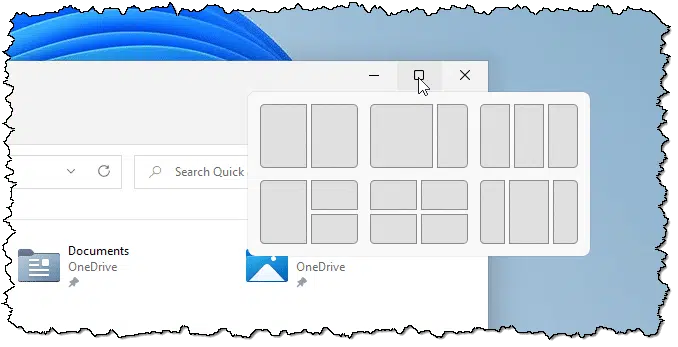
Click on the image representing the layout and position you want, and the window will move and resize to that position on your desktop.
It’s a lot like FancyZones from the Windows PowerToys collection. I expect I’ll use it a lot when I get that far.
Other additions
Microsoft Teams is included, and its chat icon is present in the Windows taskbar. (Of course, you can remove it if you don’t use Teams.)
A new feature called “Widgets” displays a collection of, well, widgets, when clicked in the taskbar.
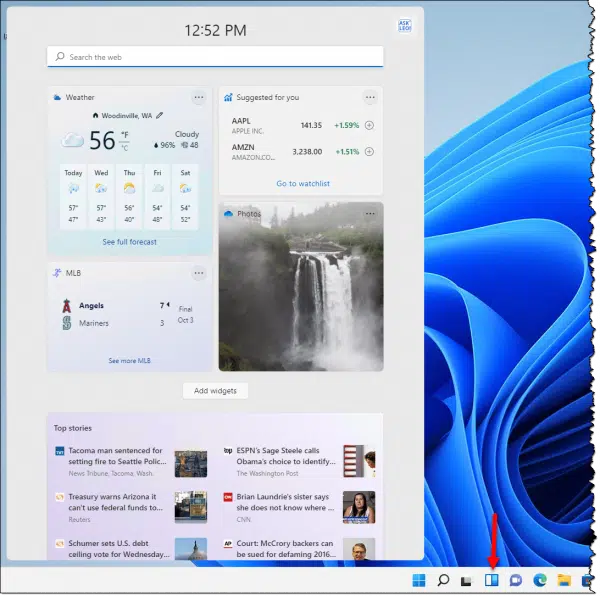
This looks very much like a similar feature added to Windows 10’s taskbar (to less than stellar reviews) not long ago.
This leads to another observation.
Not everything new is new
Many of the features Microsoft mentions as being new in Windows 11 are actually in Windows 10 already (or easily added).
- Microsoft Teams can be installed in Windows 10.
- The new Microsoft Store looks very much like the old Microsoft Store, with the revamped Windows 11 look and feel and additional marketing from Disney.
- Windows Security is being touted in some of Microsoft’s materials. It’s already built in to Windows 10.
- Virtual Desktops have been improved, but I’m not seeing how. They work fine for me in Windows 10, and I use them heavily.
Before you use new features in Windows 11 as a reason to upgrade, make sure you don’t have them available already in Windows 10.
Not everything new is good
It turns out that it can be extremely difficult to set a new default browser in Windows 11. At its worst (and, naturally, the worst turns out to be the most likely scenario) it now involves making multiple changes in the Settings app to make the switch.
I honestly expect and hope that this will be one of the first issues addressed in Windows 11 updates. As it stands, it’s bound to cause a significant amount of not-very-positive feedback.
Getting Windows 11
There are three approaches to getting Windows 11.
- Get a new machine with it pre-installed.
- Run Windows Update, and eventually it’ll show Windows 11 as an available update.
- Download and run the Windows 11 Installation Assistant, or create an ISO image.
You don’t need to update to Windows 11
That’s just a cursory overview of my initial reactions to Windows 11. It’s nice, but there’s no rush.
And, to be clear:
- You do not need to update to Windows 11.
- No one is forcing you to update to Windows 11.
- You probably don’t need a new machine to update to Windows 11, unless your machine is quite old.
- Windows 10 will be supported at least into 2025 — a full three years from this writing.
As I said, I’m somewhat underwhelmed with Windows 11. I suspect that’s a good thing. The number of changes aren’t overwhelming, and certainly none are what I’d consider to be catastrophic (except maybe for that default browser change thing). It’s an upgrade that’s not compelling, yet interesting enough to perhaps take at your leisure.
Right now, though, unless you just can’t contain yourself, I recommend not updating to Windows 11. Wait for more of the dust to settle and issues to be discovered and worked out.
Windows 10 is just fine.
Do this
Subscribe to Confident Computing! Less frustration and more confidence, solutions, answers, and tips in your inbox every week.
I'll see you there!




I have a 4-year-old Dell XPS with Windows 10 Pro. I haven’t had any problems with it and would like to upgrade it to Windows 11 but the Microsoft test says the processor isn’t compatible. The computer is out of warranty and I would like to know if it’s possible to upgrade the processor to one that is compatible. I’m satisfied with the way I have this computer set up and I never called Dell Tech Support since it hasn’t been a problem. Any thoughts about upgrading the processor to have this computer run Windows 11?
In general, no. Processor upgrades are limited by motherboard capabilities, and the jump you need is very likely not supported by the motherboard in your computer.
That being said I have heard some unofficial rumors that Windows 11 may end up supporting more of the older processors over time. All I can advise is be patient.
I’ve installed Windows 11 on my Dell Inspiron 3793 laptop. I used the Windows 11 Installation Assistant to do so. The switch from Windows 10 Pro to Windows 11 Pro went without a hitch and all programs and files stayed where they were supposed to be.
There are some things with Windows 11 I wasn’t totally impressed with, so I went to ElevenForum to see what Shawn Brink had come up with. (No, I’m not a power user.) It was while I was doing so that I found out Windows Security has tightened up considerably. Microsoft really doesn’t want people playing with fire and will initially block any files that may harm the system from downloading at all. It requires a couple of extra steps to do so, which I see as a good thing. One has to know what they’re doing with their system to get past the Windows Security safeguards.
As is typical with major Windows changes, some things in Windows 11 are good, consolidating the Settings app for example. Other things not so great, such a right clicking a file and having to choose More Options in the context menu that opens to get to the real context menu.
It will take a little time to adjust to some of the changes. After using Windows 11 for several days, I get the feeling there were a lot of changes made under the hood that are not visible. Windows 11 seems to start quicker and a little more responsive than 10. Time will tell.
Microsoft is getting too heavy-handed forcing Edge down people’s throats. I expect you’ll do do an article on changing the default soon.
If the EU does what they’ve been doing, they may force Microsoft to change that default. They did that with Windows Media Player and even forced a European edition which didn’t include the Windows Media Player, and I thing they did something similar with Internet Explorer.
Yeah, I’m really surprised that Microsoft is being so heavy-handed on this one. You’d think they would have learned from earlier attempts. You want people to use your browser? Great! Then MAKE IT A BETTER BROWSER.
I thought Microsoft lost a law suit with the US government many years ago when they tried forcing Internet Explorer on everyone. Making it very difficult to change the default browser sounds like it’s pretty much the same thing.
I take no issue with them bundling whatever software they want with Windows, but it shouldn’t be difficult to switch out a piece of software.
That’s one of the reasons I’m cautiously optimistic that the current state of affairs won’t last. We’ll see.
A very wise IT guy I used to work with had a susscinct comment that fit too many situations like Microsoft’s push for transitioning to Windows 11. It was simply:
We can’t stand any more “improvements!”
I’m sticking with Win 10 Pro until they stop support b/c Windows 11 has nothing worthwhile to offer (yet)… and some things I’d rather avoid.
I think I’ll pass on being a Windows 11 tester. Windows 10 works fine for now and so will Windows 11 in about 6 months to a year.
Interestingly, events (which I think I’ll outline in next week’s TEH Podcast) have caused me to dive head-first into the deep end.
That’s part of your work for Ask Leo! But you still have other non-Windows 11 machines and aren’t really dependent on Windows 11. I might install it on one of my lesser used machines to play with it, but not yet on my often used machines.
I agree. I will continue using Windows 10 as long as I can. I am comfortable using this system without any major issues. As the saying goes “don’t fix it if it ain’t broken”!
Personally I think Win11 is doomed to fail and continue on with Microsoft’s good/bad/good/bad OS cycle (which has held since at least Win98 to date) and if that continues, Win11 will be part of the ‘bad’. the main reason I see it failing is system requirements are to steep and requires hardware that’s a bit too recent (CPU’s roughly 4-5 years old tops (and some other things)) which eliminates a lot of competent hardware, which is probably safe to say most computers are not supported with Win11.
so assuming Windows 11 fails (as I don’t see it reaching wide adoption like how WinXP/Win7/Win10 have as those three pretty much dominated the last two decades or so), at least people can continue to use Win10 til Oct 2025 since that’s when Microsoft drops support of it. so then people can either go to whatever is the newest Windows at the time, or switch to Linux if they want to continue using a secure OS. if Microsoft keeps up with the requirements they got for Win11 that’s going to basically force people to use Linux assuming they want a secure OS to use online after Microsoft drops support of Win10 in Oct 2025.
Caution: For Windows 11 Home you can no longer have a local user account to sign in. You need a Microsoft account and an internet connection, otherwise you have a brick. Windows 11 Pro doesn’t have this restriction. So far.
I’m particularly interested in having a simple native support for Android apps, but my PC can’t handle Win 11 yet. I’ve been upgrading components over time but my motherboard is at least 10 years old. Now to decide whether to make more upgrades or start from scratch with a new system.
Don’t count on Android support to be a real or reliable thing. So far it’s marketing hype and isn’t available. The chances of MS making this fully functional and debugged for most apps is near zero. Then there is MS’s fickle commitment to such utilities. At the first indication of any problem they’ll drop it. But, the big caveat is Google. Do you think that Google is going to allow a Windows machine to be an alternate platform for Android apps and take a hit on Chromebooks and Android pads? Another potential threat to Google will be a resurrection of Windows cell phones if Android apps truly worked on Windows 11.
There are already Android emulators available for Windows for free.
If you look at it from a neutral standpoint, Windows 11 is WIndows 10 with some restrictions due to [understandably sensible] enhanced security requirements for those who need it, and some ‘enhancements’ that Microsoft have chosen not to implement in Windows 10, to act as a ‘temptation’ for those who otherwise don’t need it.
Windows 11 isn’t a replacement, as all other ‘new’ Windows are/were, since Windows 10 will continue to be updated for the forseeable future. I tell all my colleagues that it is, in effect, “Windows 10 – Secure Edition”.
Estimates suggesting that systems up to 4-5 year years old are capable of Win 11, I would suggest, a bit optimistic. And many of us have systems older than that working very capably but don’t work with Win 11. [My Intel Core i3 4150 with 8GB RAM and SSD disk works very well but is ‘too old’, as it predates the Intel 8xxx series and only has TPM 1.2].
I expect that in a year, we’ll see some revised ‘roadmap’, once initial new sales for Xmas/Thanksgiving have dwindled and no-one else updates.
I think it’s worth a mention that there is a side result of these continual “upgrades” … A significant proportion of e-waste produced every year is exported from high-income countries to low- and middle-income countries, where there may be a lack of regulation, or where regulation does exist, it may be poorly enforced. Here, e-waste is dismantled, recycled and refurbished in environments where infrastructure, training and environmental and health safeguards may be non-existent or poorly adhered to. The health of millions of children, adolescents and expectant mothers worldwide is jeopardized by the informal processing of discarded electrical or electronic devices according to a new ground-breaking report from the World Health Organization: Children and Digital Dumpsites.
That’s not an argument for stopping progress. That’s an argument for reducing e-waste, and dealing with it responsibly.
I’ve been playing with Windows 11 for a week now. A few things I worked out:
1. Mozilla seemed to have prepared for Windows 11. Rather than going to Settings to make Firefox the default browser, it is much simpler to open Firefox, go to Settings in Firefox and select “Make Firefox the default browser”. Doing that, and then going to Settings>Apps>Default Apps in Windows 11 and checking the settings for Firefox, most of the necessary changes had been made already.
2. In the Start Menu, it is possible to arrange apps in the order or group (sorta) you want by removing all of the apps pinned to Start, then going through the list of all apps and pinning the ones you want on Start in the order that you want them to appear, one by one. Can only pin 18 apps to Start. Clunky, but it worked.
One of the frustrating issues with Windows 11 is that it places the Task Bar only at the bottom of the screen. This can be overcome with Start11 from Stardock.com which allows you to place the Task Bar at the top of the screen and to place all the icons (including the Start button) to the left. It also lets you easily with one click of the mouse, to replace the Windows 11 Start Menu with a Windows 7 style Start menu or a more modern style Start menu. It offers lots of other customizations not allowed by Windows 11 including restoring the Taskbar context menu and expanding search capabilities. I think it sells for $4.99 per computer license. I do not work for Stardock or have any financial investment in them — I’ve just been using their replacements for Windows’ Start Menu going back to Start8. https://www.stardock.com/products/start11/
As well, I am underwhelmed with Windows 11 which I installed some time back in a virtual machine as part of the Windows Insider preview program. As to the UI changes – whoop-di-freakin’-do. Remember when MS made such a big deal about Aero as the new wave in user interface design? Then a few years later they ditched Aero in favour of the next new wave, which was the flat look. Then later on still, Aero features started creeping back in.
Let’s talk about Widgets. They were introduced years ago, then, when the many security vulnerabilities they exposed became apparent, they were disabled and abandoned. Now they are back.
To be honest, the only new feature I am looking forward to is the ability to run Android apps under Windows. Perhaps then I will be able to successfully pair two different fitness tracking apps at the same time – something that I have been unable to do on my Android phone. I expect this feature will be late, poorly implemented and difficult to configure.
I wish the people at Microsoft, instead of making random changes and touting them as the next big thing, would instead concentrate on:
1. Making the system more secure
2. Making the interface more consistent
My ‘production’ machine is my desktop PC. It currently runs Windows 10, dual-booted with KDE-Neon Linux. This is a new PC. I started selecting it’s components a bit before Windows 11 became a topic of discussion (a few months before it became available to Insiders). When the components I ordered arrived, I put the new machine together. It is working very well I am happy to say.
Windows Update reports that my desktop PC can run Windows 11 (even though I selected it’s components before I knew ’11 was coming), but I’m in no rush. There have been a host of articles describing the security features employed by Windows 11 (and how to enable them in Windows 10), so I have enabled all of them (that I know about) to improve (and harden) my PC’s security in Windows 10. I keep an open format document recording the steps to duplicate these security ‘enhancements’ so I can replicate or reverse them if needed. I keep track of any configuration change I make in this document for the same reasons.
At the same time I ordered the components for my new desktop PC, I also ordered a new Lenovo Legion 5 gaming laptop. I installed Window 11 on it making it part of the Windows Insiders Program so I could see what all the fuss is about. When Windows 11 became generally available (recently), I performed a clean install, removing the new laptop from the Insiders program, but keeping Windows 11 as the laptop’s Windows OS (I want to see what changes come for regular users). It dual-boots Windows 11 with KDE Neon Linux, similarly to my desktop machine.
One thing I have learned about Windows 11 is that it is pretty to look at. Pretty is nice, but it is not a valid reason to upgrade. I am currently experimenting with the ‘new’ WSL2 that was just released to the Windows 11 store. I have not checked if WSL2 is available in the Windows 10 store yet, but I think not at this time. This change will make it possible to update WSL without a full Windows 11 upgrade. That will be much more convenient, but again, it is still not a valid reason to switch from Windows 10..
I use the Edge web browser as my default choice because I like using it (I also use Edge in Linux), so the difficulty in choosing another browser is less of an issue for me than it may be for others. At the same time, I seriously dislike any limitation to user choice regarding their OS and the components they prefer to choose as their system defaults. Microsoft should restore that functionality in its entirety to the to the Windows 11 Settings app, and perhaps require the user to complete a Windows Hello verification procedure to unlock the defaults page, then automatically re-lock it after the user completes any desired changes (e.g.: by adding a “Save” button to save any changes). Finally, the OS MUST honor the user’s wishes – period! The OS may ‘belong’ to Microsoft, but the hardware it runs on belongs to the user. Of all the reasons I may choose to drop Windows all together, user choice is very near the top for me.
I have a second laptop that does not meet the Windows 11 system requirements (a Dell Inspirion 5555). The CPU is too old, and cannot be updated. It meets every other requirement, Secure Boot, a TPM2 module, enough RAM, and a large enough hard drive. The fact that it cannot have Windows 11 is fine with me. I will continue to use it with Windows 10 until 2025. At that time, if Windows 10 actually reaches it’s end of life, I’ll remove it, and run that laptop as a pure Linux system.
In any case, I’ll still have what I want, computers that work well, and that are secure enough to keep me safe on the Internet as long as I employ good Internet practices, such as keeping an eye out for the ‘https’ in the address bar, and not blindly clicking links in my emails (or even on websites I visit). If I want to follow a link from either source, It only takes a few seconds to enter the URL manually to go there.
Sorry for digressing :). In my opinion, Leo is right. There is no valid reason to get your jeans in a bunch over Windows 11. I use my desktop for any real work I want or need to do, and my new laptop for entertainment and to play. (It’s a very expensive toy 🙂 ). That is why I keep Windows 10 on my desktop while I put Windows 11 on my new laptop. There is nothing on the Windows 11 laptop that will matter if I lose it, so I can use it for experimentation purposes. Experimenting is fun for me too, making it another form of entertainment for me.
Long Story Short, if you depend on your PC for any reason, and you keep information you cannot afford to lose on it, you are best served to stick with Windows 10 (and back up regularly!). If you have a secondary PC that you do not need to depend on, that is where you may want to try out Windows 11, providing it meets the new system requirements. If this is not the case, you are not missing much, so don’t fret about it.
My2Cents,
Ernie
hi leo, good timing on this mail. i just was forced to install IE11 on my old pc running win7P. it was for a bitdefender sign in. now i really dont want it and tried to uninstall it. no luck. it does not show up in programs in control panel…and i tried geek uninstall and same there…does not show. any ideas? Clas
IE11? That’s not Windows 11, which the article is about, just so everyone’s clear.
In “turn windows features on and off” (which should be a link in Control Panel’s Add/Remove programs page) you can turn off IE 11.
I was offered Windows 11 on my entertainment computer, so I figured it’s not my work machine, so what the heck, why not. I couldn’t believe how fast it installed after downloading. It was only about 10-15 minutes. No problems and barely a noticeable change. I’ve seen Service Packs that make more noticeable changes.
I don’t mind the new Start Menu, but I installed Open Shell (the continuation of the Classic Shell project) because I dimply prefer the less cluttered 2 column interface. You don’t necessarily have to dislike something to like something better.